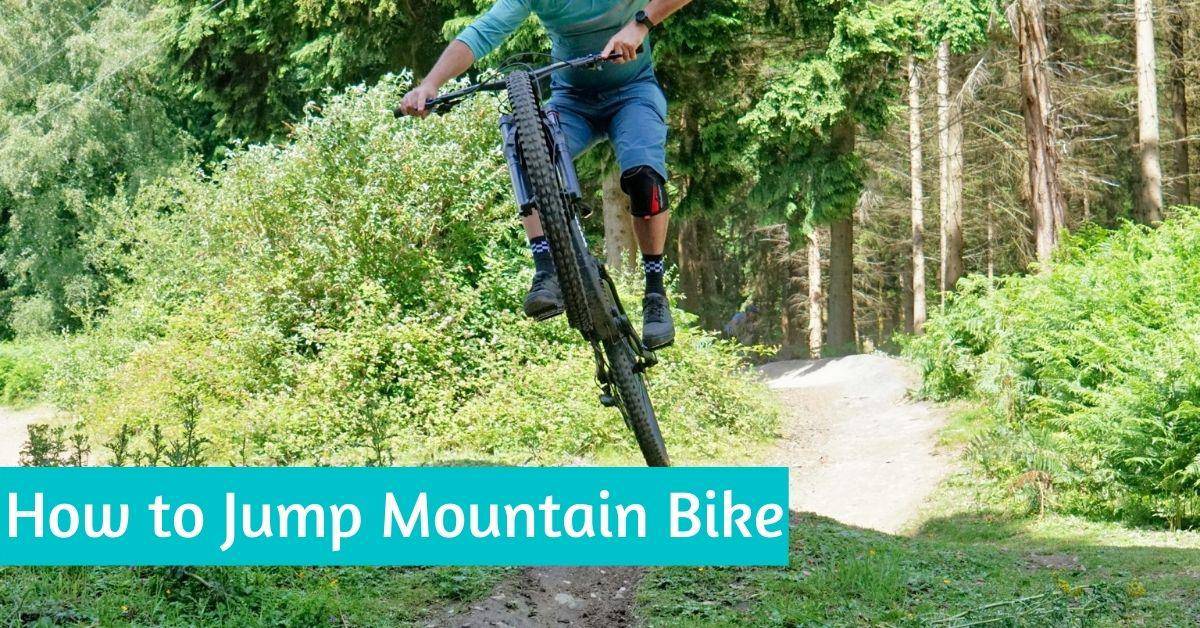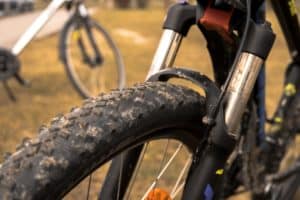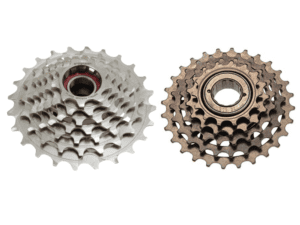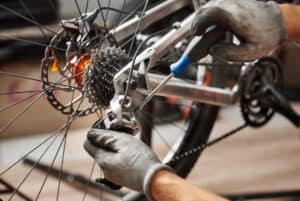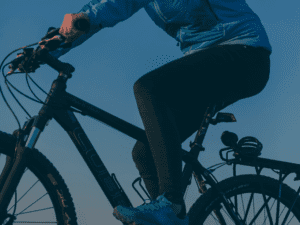Are you wondering how to jump a hardtail MTB or how to jump a full-suspension mountain bike? We have all the answers to those, and you can also learn how to jump mountain bikes with a flat pedal, which is an easier option.
Of all the techniques, jumping is perhaps the one that most riders identify with.
Gone are the days when average trail rides included small jumps here and there that required little effort. Jumps are now a feature of trail riding. Here are the steps to mastering how to jump a mountain bike.
How to Jump A Mountain Bike Step-by-Step
Step 1: Learn to Manual
A manual is just like a wheelie, but unlike the latter, you don’t pedal while doing a manual. Both techniques require you to lift the front wheel from the ground and balance on the rear wheel alone.
Manuals help you get over bumps and tiny roots while maintaining speed, but they will also help you initiate a jump.
There are two parts to getting a manual done. Getting the front wheel in the air and finding a balance point to maintain the front wheel in the air.
To get the front wheel up, preload by pushing your weight down. You’ll gain the rebound energy needed to lift the wheel. Punch as quickly as possible, and push your weight backward to push your hands and feet forward=
Getting the front wheel from the ground is easy. Balancing it in the air is the trickiest part. The key to balancing a manual is in your hips. Keep them low over the rear wheel and move them back and forward to maintain balance. Keep the finger on the rear brakes.
Step 2: The Take-Off
Find a jump that is most suitable for you, and then start moving at a comfortable speed off-saddle. Keep your weight centered over both wheels and bend slightly. Start to compress and feel the force of the lip on the front tire.
Don’t deal with both wheels together. Treat each wheel separately. Slowly start shifting your weight backward from your hands to your feet. This to ensure that the front wheel will not have any weight on it when reaching the lip.
Press down, and then release weight through each wheel as you prepare to jump, just like bunny hopping. The lip of a jump will provide the boost needed by the wheels to follow the trajectory. Jumping is less explosive than bunny hop because the lip provides you with a much-needed boost.
Step 3: Weight Transfer
It’s crucial how you transfer your weight from the hands to your feet. You are halfway up the lip, just about to jump, and it’s at this time to stop pushing with your arms and push with your feet instead.
If you push into the lip while putting weight on your arms when approaching this line, you’ll get bucked forward and over the bars. As the jump becomes bigger and your bike’s suspension increases, the line moves further back.
Related: How To Drift Your Bike
Step 4: Landing
Once you are airborne, relax! You have conquered the most challenging part. Your next concern is landing. The spot where you are going to land and absorb the impact with your arms and legs.
Try landing with both wheels simultaneously. Touching down with the front wheel first can end up badly with you going over the bars. Touching down with the rear wheel can cause the front to wash out or end up disastrous. Stay away from the brakes.
Equipment Needed for Jumping
Before hitting those jumps, there’s a handful of equipment needed. Here they are:
Drop Your Saddle
Lowering your saddle makes it easier for your bike to move freely underneath you. It also gives you plenty of room to absorb the landings. Moreover, your rear end may slam on the seat when you land and buck you off the bike if your saddle is up.
The best option is to buy a dropper seat post, which allows you to adjust the saddle height with a bar-mounted control without getting off your bike. If you ride a lot, then a dropper seat post is worth every penny.
Start with Flat Pedals
When learning to jump, start with flat pedals. You must be wondering, how do you jump a mountain bike with a flat pedal? You only have to follow the steps above, and you’ll be surprised to find how they make jumping simple.
Flat pedals will help you jump without relying on clipless pedals attached to the shoes to help lift your bike. Flat pedals will also help you escape the bike in case things go south.
Pump in some PSI
Adding air to your tires will help you gain more speed as you approach a jump. It will also keep your tubeless tires safe from rolling off the rims if you happen to land a little sideways.
Stiffen Your Suspension
Having your suspension a bit stiffer than usual can boost you and help you get off the lip of a jump better. Stiffen your suspension by switching both your shocks to “Trail” mode or adding a bit more air in them.
Put on Your Armor
The reality of learning to jump your mountain bike is that you’ll crash a couple of times. Safety and well-being come first. Get some elbow and knee pads before trying this out. Should I mention that you should have a helmet on? That’s so obvious!
Some riders prefer a full-face helmet that protects the sides of the head. Biking gloves are also a worthy investment. Apart from providing a grip while you ride, they also protect your hand from bruising if you crash.
Why Jump?
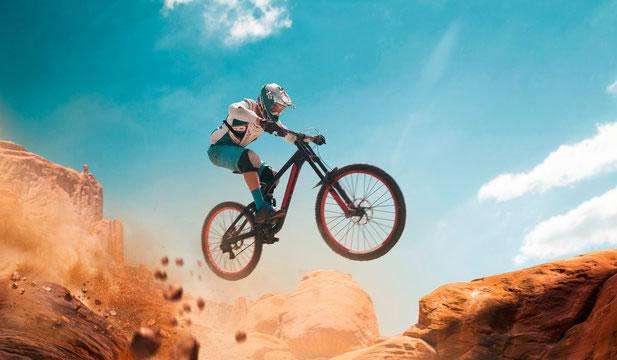
If you can jump and control your jumps, then getting your wheels airborne is the best feeling ever. The experience of floating for a few seconds becomes addictive, and fun. It also gives you the privilege to open up an entire world of possibilities when you want to link features together during a ride.
If you can choose where to go heavy and where to go light during a jump, you can apply the same technique to texture trails and obstacles. This means you can generate traction control and enjoy a floaty feeling over features that gave you a headache before.
What’s the Feeling?
Jumps make the best feeling for a rider. From the outside, one might think a jump is thrilling and exciting. It looks explosive and like an unseen force is firing you into the air. In reality, you are jumping because you are confident and smooth.
Whether you are riding a full suspension or a hardtail, a smooth jump comes from making slow movements and bringing your weight back for consistent pressure and drive. Once you are in the air, you’ll feel like you want to be there for longer, so you end up doing more jumps.
The effort involved in jumps is utilized on the ground. The airtime should feel like you are floating and locked into the stability attained from the takeoff.
Practice
Practice makes perfect! The more you practice, the more speed and compression you add, and you’ll be flying higher and further every single time. It will take some time to calibrate your mind, body, and your bike to take off and land precisely where you wish.
Experiment with being in control of your landing, both wheels, front first or rear first, then move on to your height and distance.
Table-top jumps are the best places to raise your jumping skill level. If you fail to make a landing on a tabletop, it’s still safe to land on the top of the jump.
However, when it comes to a double, you have to land in the right spot, or you will crash.
Top Jumping Mistakes People Make
- Feet going off the pedals: Your feet going off the bike will only mean pushing the bike from the body. Wear the right biking shoes and use specific flat pedals. You can also go clipless.
- Front-wheel twisting in the air: Turning your front wheel intentionally is incredible. Unintentionally turning the same wheel in the air will end in disaster. Focus on guiding the bike and handlebars up, and no tugging.
- Not clearing the table: Look at your compression. The biggest mistake riders make is failing to compress on the take-off of the jump. If you fail to compress, you will get pulled back down like Newton’s apple. Compression is the action of putting your weight quickly and allowing the bike to come up under you. Stomp on those pedals hard.
- Overshooting the landing: this happens if you let your bike determine where you should go instead of telling it where to. You are the boss. You get to decide where you would like to land.
FAQs
Can you jump a 29er hardtail?
Yes, you can jump a 29er hardtail, and it’s much more enjoyable. However, you will be voiding the warranty, so while you enjoy it, do it at your own risk.
A niner hardtail is not meant for that kind of activity, but it can handle small jumps comfortably. The forks may limit you, depending on the type you are using.
The wheels will also not last long if you start jumping your bike, the rear wheel especially. However, if the shop doesn’t catch you jumping the bike or you don’t tell them, you will not void the warranty.
Can you jump on a trail bike?
Yes, of course. The trail bike will hold up a jump comfortably. In fact, it happens all the time. You can do up to 2-foot jumps with your trail bike, and it will be just fine.
Some people even do 4-foot jumps and push the limits further, but that’s when you start damaging your bike.
What happens is that when you jump too high, the suspension will not cushion the landing enough, leading to stress on the frame. That’s how you start messing up the bike.
How do you clear a jump?
The only hack through this is practice, and the technique will develop. Practice jumping on a flat trail, ride fast, preload, then spring. When you have a jump to help you, it should be easier.
The reason why you don’t get enough air is that your moving speed is lower, or the jumps have no lip. It would be best if you increase your speed before approaching the face of the jump.
Preload, as you hit the face and rebound, will lift you and your bike. The bigger the tabletop, the more speed you need to create the transition.
Are Hardtails good for jumps?
Hardtails are great bikes for jumps. You can boost and float in the air. They are only sensitive when you land. There must be a reason why dirt jumps and trial bikes are all hardtails.
You can even use a full rigid to take jumps. Just try to land in finesse, and it will be alright. People performed jumps before there were fancy suspension systems. All they needed were strong wheels.
If your body can take the rear shock, you can jump with a hardtail with no worries. You only need a strong back wheel. BMXers will laugh at this question and answer you with action.
How do you hit a gap jump?
If you already know how to jump, then you can learn how to gap jump. In most cases, it’s better to overshoot the landing than to land shortly after jumping. Try following another rider if you are doing it for the first time and moving at the same speed. This will help you get a nice pump.
To perform a successful gap jump, you need to get your speed right. You can also start with small doubles or lippier doubles, and they will get your comfortable in the air and help you land just fine.
However, most riders believe that you should gain more speed to perform a gap jump, but you need to be careful and avoid hitting a gap with excessive speed to prevent accidents.
Conclusion
As you can see, jumping a mountain bike is not hard if you get a hack of it. Start by learning a tabletop jump before trying a double. Don’t go too big yet. If you have any questions, direct them to us, and we’ll do everything in our power to answer them.
